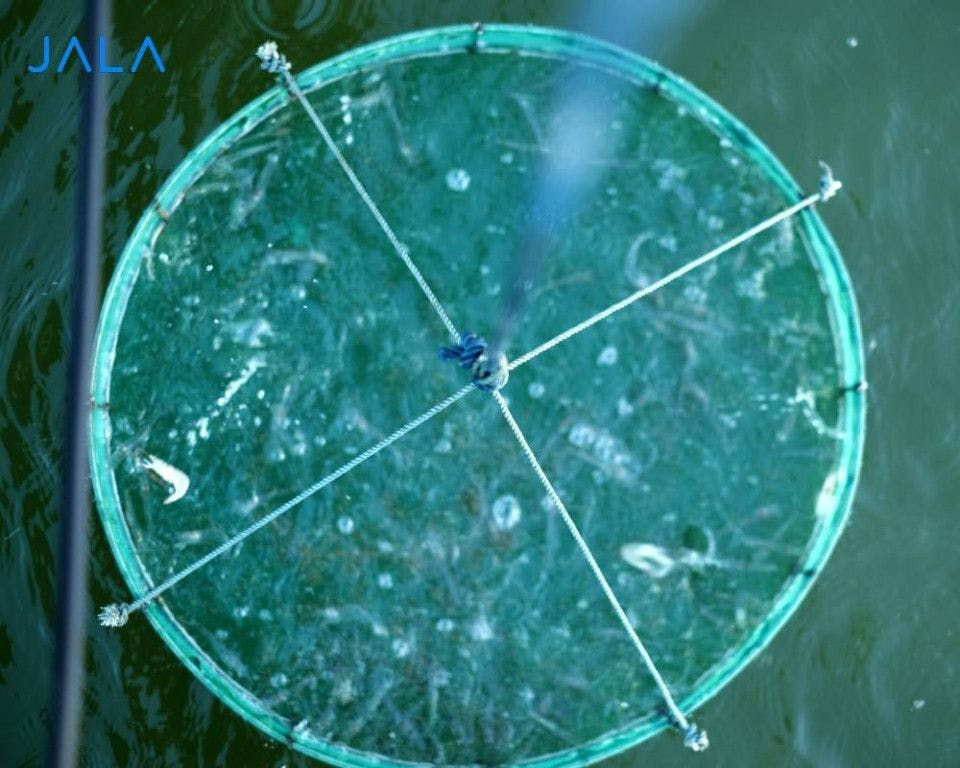
The source of disease in shrimp cultivation is determined by 3 factors, namely pathogens (agent), host, and the environment. Disease occurs due to an unbalanced interaction between the environment, host (shrimp), and disease-causing organisms (pathogens). This unbalanced interaction causes stress in shrimp, weakening their defense mechanism and making them more susceptible to disease.
Aside from bacteria (Read more: Harmful Bacteria Diseases in Shrimp Farming), shrimp disease can also be caused by viruses, in which it is called a viral disease. Mortality due to viral infection ranges from 80 to 100%, depending on the severity of the infection.
Some viruses that cause shrimp disease are the white spot syndrome virus (WSSV), taura syndrome virus (TSV), infectious hypodermal and hematopoietic necrosis virus (IHHNV), infectious myonecrosis virus (IMNV), and covert mortality virus (CMV).
White Spot Syndrome Virus (WSSV)
White spot syndrome virus (WSSV) causes white spot disease in shrimp. The replication rate of this virus increases under higher temperatures. This virus can spread due to cannibalism or predation. Dead or live shrimp infected with WSSV can still spread the virus when transported in frozen condition without prior cooking through contact or indirect contact.
Clinical symptoms that may appear in infected shrimp are white spots with a diameter of 0.5-2 mm, color change from pink to reddish throughout the entire body, and loss of appetite. After a few days, shrimp may appear to be dying or swimming on the surface of the pond.
Taura Syndrome Virus (TSV)
TSV causes Taura Syndrome. Infection may occur 14-40 days after stocking. This virus spreads through shrimp cannibalism. Shrimp acutely infected with TSV can be identified by having a paler body and a redder uropod and pleopod compared to the rest of the body. TSV-infected shrimp also has a softer shell and empty gut. This often happens towards the end of the molting cycle.
Infectious Hematopoietic and Hypodermal Necrotic Virus (IHHNV)
Juvenile shrimp infected with IHHNV undergoes abnormal growth, shiny white body especially in the abdominal joint, bluish body, and defected rostrum growth on either side. IHHNV also spreads through cannibalism.
Infections Myonecrosis Necrotic Virus (IMNV)
IMNV, myonecrosis, or commonly known as myo may infect shrimp through every stage of their life cycle, from larva to mature shrimp. This virus causes less mortality compared to other viruses, but can infect together with MrNV or WSSV. This virus spreads through cannibalism in shrimp or due to other vectors such as Artemia.
Initial symptoms of the disease can be detected through a change in shrimp behavior or physical appearance, loss of appetite, and increasing mortality. Infected shrimp will have a murky white flesh, especially around the abdomen and tail.
Covert Mortality Nodavirus (CMNV)
CMNV causes Covert Mortality Disease, in which infected shrimp will die at the bottom of the pond instead of the surface or side. CMD is rampant in China. It commonly occurs 1 month post-stocking and farmers are not always aware of the early mortality.
Some symptoms of the disease are a paler hepatopancreas, empty gut, softer shell, and slowed growth. The muscles may also turn whitish around the abdomen.
Dealing with shrimp diseases
Farmers need to implement a basic philosophy of health management strategies to deal with shrimp disease. There are three integrated components for farmers to focus on. The first one is the provision of a healthy environment, which begins with choosing the proper cultivation location, cultivation design and construction, system, and water quality management. Next, healthy shrimp originates from high quality and pathogen-free broodstock to obtain healthy shrimp fry. This also requires sufficient feed (both quantitatively and qualitatively) and regular monitoring. Finally, farmers should implement biosecurity measures to mitigate pathogens.
Intensive and semi-intensive cultivation systems which are widely used in Indonesian shrimp farms are highly at risk of poor water quality. Therefore, farmers should prioritize those three components together to ensure that their shrimp is in good health. Administering additional supplements also helps to strengthen shrimp immunity to increase their chances of survival against diseases.
Resources:
Amri, Khairul dan I. Kanna. 2008. Budidaya Udang Vaname: Secara Intensif, Semi Intensif, dan Tradisional. PT Gramedia Pustaka Utama. Jakarta.
Liu, B., Z. Yu, X. Song, and Y. Guan. 2007. Studies on The Transmission of WSSV (White Spot Syndrome Virus) in Juvenile Marsupenaeus japonicus Via Marine Microalgae. Journal of Invertebrate Pathology. 95: 87-92.
Novriadi, R. 2013. A Toolbox of immune system for Artemia. Master thesis, Ghent University, Belgium. 89 pp.
Prasad, K. P., K. U. Shyam, H. Banu, K. Jeena, and R. Krishnan. 2017. Infectious Myonecrosis Virus (IMNV) - An Alarming Viral Pathogen to Penaeid Shrimp. Aquaculture. 477: 99-105.
Turkmen, G. and E. Toksen. 2015. Biosekuriti and Major Disease in Shrimp Culture. 606-615.
Tuyen, N. X., J. Verreth, J. M. Vlak, and M. C. M. de Jong. 2014. Horizontal Transmission Dynamics of White Spot Syndrome Virus by Cohabitation Trials in Juvenile Penaeus monodon and P. vannamei. Preventive Veterinary Medicine. 117: 286-294.
Read more:





